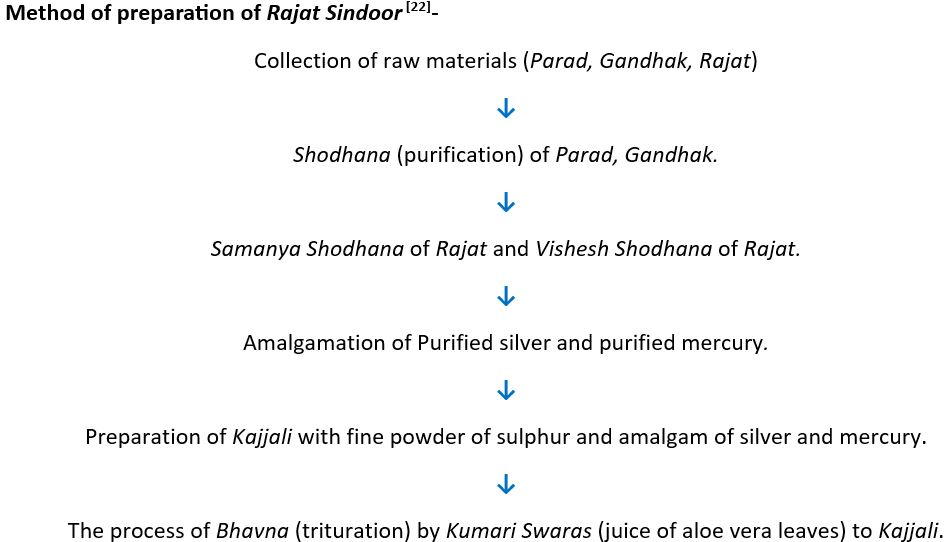A Study Protocol for Pharmaceutico-Analytical study of Rajat Sindoor and evaluation of its Anti-Cancer Activity against Leukaemia using HL60 and K562 cell line model
DOI:
https://doi.org/10.21760/jaims.10.4.8Keywords:
Leukaemia, Anti-cancer activity, Kupipakwa Rasayana, Rajat Sindoor, HL60 cell line, K562 cell line, Study Protocol, RasaushadhiAbstract
Introduction: Leukaemia is a disease of haematological malignancies that result from the abnormal multiplication of developing leukocytes. A patient suffering through leukaemia experiences an aberrant blood cell synthesis, usually involving leukocytes (white blood cells). Leukaemia is categorized into two groups, based on the cell types that are mostly involved: Lymphoid and Myeloid, also based on the disease's natural course: Acute and Chronic. Neoplasms and Vyadhi Arbuda, which is mentioned in the classics of Ayurveda (Charaka Samhita and Sushruta Samhita), are comparable. Rasa Aushadhis have many therapeutic advantages in many chronic health aspects such as CKD, Cardiac conditions, Inflammatory conditions, bleeding disorders, cancers, etc. Rajat Sindoor is one of the effective Rasa Kalpas found no previous work on in-vitro investigation to assess the anti-cancer activity w. s. r. to Leukaemia.
Materials and Methods: Rajat Sindoor will be prepared as per classical reference. The prepared formulation will be assessed with organoleptic characters and physio-chemical parameters. The Experimental study will be carried out according to the OECD guidelines.
Result: The analytical parameters will be assessed to establish pharmaceutical standardization. The experimental study and statistical analysis will be done accordingly.
Discussion: The purpose of the current study is to evaluate Anti-cancer activity of Rajat Sindoor w. s. r. Leukaemia using HL60 and K562 cell line model. A small step to fill the research gap in the treatment aspect of Leukaemia from Ayurvedic point of view will be done. If significant positive results are obtained in this work, then it will be a valuable contribution in the treatment of leukaemia.
Downloads
References
Bhavsar VCK, Ramteke VV. Pharmaceutico-analytical study of Panchanana Rasa and evaluation of its anti-inflammatory activity in myocarditis using LPS-induced inflammation in cardiac cell line H9C2. J Ayurveda Integr Med. 2024;12(1).
Savrikar S, Ravishankar B. Introduction to ‘Rasashaastra’—the iatrochemistry of Ayurveda. Afr J Trad Compl Alt Med [Internet]. 2011 Jul 15 [cited 2024 Jun 12];8(5S). Available from: http://www.ajol.info/index.php/ajtcam/article/view/67955
Tiwari DDD. A critical review on Kupipakwa Rasayana. J Ayurveda Res. 2024;6(11).
Khedekar K, Barve M, Khedekar S, Chondikar S. Kupipakwa Rasayana: unique metalo-mineral preparation. J Ayurveda Integr Med Sci [Internet]. 2017 May 4 [cited 2024 Jun 12];2(2). Available from: http://www.myresearchjournals.com/index.php/JAIMS/article/view/7728
Galib, Barve M, Mashru M, Jagtap C, Patgiri BJ, Prajapati PK. Therapeutic potentials of metals in ancient India: a review through Charaka Samhita. J Ayurveda Integr Med. 2011;2(2):55–63.
Mathew KG, Aggrawal P. Medicine: Prep Manual for Undergraduates. 5th ed. p. 42.
Davidson S. Principles and Practice of Medicine. 23rd ed. 2018. p. 955.
Siegel RL, Miller KD, Jemal A. Cancer statistics, 2016. CA Cancer J Clin. 2016;66(1):7–30.
Arora RS, Arora B. Acute leukemia in children: a review of the current Indian data. South Asian J Cancer. 2016;5(3):155–60.
Davidson S. Principles and Practice of Medicine. 23rd ed. 2018. p. 954.
Golwalla AF. Golwalla’s Medicine for Students: A Reference Book for the Family Physician. 25th ed. New Delhi: Jaypee; 2017. p. 382.
Mathew KG, Aggrawal P. Medicine: Prep Manual for Undergraduates. 5th ed. p. 47.
Golwalla AF. Golwalla’s Medicine for Students: A Reference Book for the Family Physician. 25th ed. New Delhi: Jaypee; 2017. p. 387.
Mathew KG, Aggrawal P. Medicine: Prep Manual for Undergraduates. 5th ed. p. 44.
Sushruta. Sushruta Samhita; Nibandhasangraha by Dalhana. Ed. Yadavji Trikamji Acharya. Varanasi: Chaukhamba Sanskrit Sansthan; 2009. Nidanasthana 11/14; p. 311.
Suśruta, Ḍalhaṇa, Gayādāsācārya. Suśruta Saṃhitā: Śrī Ḍalhaṇa Ācārya kī Nibandha Saṅgraha vyākhyā tathā Śrīgayadāsa Ācārya kī Nyāya Candrikā vyākhyā kā Hindī Anuvāda. Vol. 2. Varanasi: Chaukhamba Orientalia; 2016. Chikitsasthan, Chapter 18.
BV, Chacko J, Kundagol MC, Soman D. A review on Ayurvedic perspective of neoplastic disorders with special reference to leukemia. Int J Res Ayurveda Pharm. 2018;9(3):118–23.
Dvivedī V. Rasendra Sambhava. Vol. 41. Varanasi: Kr̥ṣṇadāsa Akādamī; 1997.
Ayurved Saar Sangrah. Shri Baidyanath Ayurved Bhavan Ltd.; 2015.
Bray F, Laversanne M, Sung H, Ferlay J, Siegel RL, Soerjomataram I, et al. Global cancer statistics 2022: GLOBOCAN estimates of incidence and mortality worldwide for 36 cancers in 185 countries. CA Cancer J Clin. 2024;74(3):229–63.
Bing [Internet]. [cited 2024 Jul 12]. Globocan India 2022. Available from: https://www.bing.com/images/search?q=globocan+india+2022&qpvt=globocan+india+2022&FORM=IQFRML
Madgulwar Y, Belge R, Ramteke V. Pharmaceutico-analytical study of Rajat Sindoora: a conceptual framework and empirical exploration. Int J Pharm Res Appl. 2023;8(1):2175–81.
Basu J, Madhulika S, Murmu KC, Mohanty S, Samal P, Das A, et al. Molecular and epigenetic alterations in normal and malignant myelopoiesis in human leukemia 60 (HL60) promyelocytic cell line model. Front Cell Dev Biol. 2023;11:1060537.
Karagiannis TC, Wall M, Ververis K, Pitsillou E, Tortorella SM, Wood PA, et al. Characterization of K562 cells: uncovering novel chromosomes, assessing transferrin receptor expression, and probing pharmacological therapies. Cell Mol Life Sci. 2023;80(9):248.
Agrawal K. Parad Samhita. Mumbai: Khemraj Shrikrushnadas; 1993. Chapter 30, verse 85; p. 237.
Rathi M, Rathi S. A critical study of Gandhaka Shodhana. J Ayurveda Integr Med Sci. 2023;8(5):185–8.
Naikare TS, Rao KS, Kulkarni RM, Sakhitha KS, Thakur RS, Chaudhari M, et al. Synthesis and characterization of Rajat Bhasma and its in-vitro anti-cancer activity. NeuroQuantology. 2022;20(14):171.
Analytical assessment of Rajata Sindura.
Gokarn RA, Gokarn SR, Hiremath SG. Process standardization and characterization of Rajata Sindura. AYU. 2014;35(1):63.
Gupta LN, Kumar N, Yadav KD. XRD and XRF screening of Yasad Bhasma. 2010;5.
Sarkar MK, Mahapatra SK, Vadivel V. Oxidative stress-mediated cytotoxicity in leukemia cells induced by active phyto-constituents isolated from traditional herbal drugs of West Bengal. J Ethnopharmacol. 2020;251:112527.
Peters JM, Ansari MQ. Multiparameter flow cytometry in the diagnosis and management of acute leukemia. Arch Pathol Lab Med. 2011;135(1):44–54.















